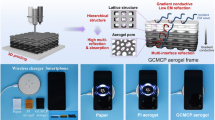Abstract
There are significant theoretical and manufacturing errors when multiple planar diaphragms are pieced together to create large-diameter, high-curvature membrane reflectors. To address this challenge, a thermoplastic forming technique for creating doubly curved paraboloid membrane reflectors for the Electrostatically Controlled Deployable Membrane Antenna (ECDMA) is proposed. Initially, a creep model for the membrane reflector is developed using finite element analysis, and creep parameters of the membrane are determined through experimental testing. To validate the effectiveness of this thermoplastic forming technique, simulations and experiments are conducted on a membrane reflector with a diameter of 0.3 m. It is evident that the simulation results have good prediction for experiment results with errors under 5%. Furthermore, this method has been applied to a 2-m ECDMA prototype, demonstrating a surface accuracy improvement of over 70%.
















Similar content being viewed by others

Data availability
Replication of results: The results presented in this study can be replicated by implementing the formulas and data structures presented in this study. The code and data for producing the presented results will be made available by request.
References
Duan BY (2020) Large spaceborne deployable antennas (LSDAs)-a comprehensive summary[J]. Chin J Electron 29(1):1–15
Chandra M, Kumar S, Chattopadhyaya S et al (2021) A review on developments of deployable membrane-based reflector antennas[J]. Adv Space Res 68(9):3749–3764
Li MJ, Li M, Liu YF, Geng XY, Li YY (2022) A review on the development of spaceborne membrane antennas. Space Sci Technol 2022:9803603
Chodimella S, Moore J, Otto J, Fang H (2006). Design evaluation of a large aperture deployable antenna. In: 47th AIAA/ASME/ASCE/AHS/ASC Structures, Structural Dynamics, and Materials Conference 14th AIAA/ASME/AHS Adaptive Structures Conference 7th (p. 1603).
Pearson J, Moore J, Fang H (2010). Large and high precision inflatable membrane reflector. In: 51st AIAA/ASME/ASCE/AHS/ASC Structures, Structural Dynamics, and Materials Conference 18th AIAA/ASME/AHS Adaptive Structures Conference 12th (p. 2500)
Flint E, Lindler J, Hall J, Rankine C, Regelbrugge M (2006). Overview of form stiffened thin film shell characteristic behavior. In: 47th AIAA/ASME/ASCE/AHS/ASC Structures, Structural Dynamics, and Materials Conference 14th AIAA/ASME/AHS Adaptive Structures Conference 7th (p. 1900)
Flint E, Lindler J (2007). Coupled structural dynamics of membrane aperture shells and their periphery support structures. In: 48th AIAA/ASME/ASCE/AHS/ASC Structures, Structural Dynamics, and Materials Conference (p. 1843).
Flint E, Lindler J (2007). Self supporting hexagon shaped membrane aperture thin film shells. In: 48th AIAA/ASME/ASCE/AHS/ASC Structures, Structural Dynamics, and Materials Conference (p. 1841).
Coleman MJ, Baginski F, Romanofsky RR (2012) Effect of boundary support and reflector dimensions on inflatable parabolic antenna performance. J Spacecraft Rockets 49(5):905–914
San B, Wu Y, Sun X (2014) Shape error study of inflatable antennas using a numerical model[J]. Acta Astronaut 104(1):11–25
Gu Y, Du J, Yang D et al (2018) Form-finding design of electrostatically controlled deployable membrane antenna based on an extended force density method[J]. Acta Astronaut 152:757–767
Nishi M, Kaburagi T, Kurose M, Hirashima T, Kurasiki T (2014) Forming simulation of thermoplastic pre-impregnated textile composite. Int J Mater Textile Eng 8(8):779–787
Datashvili L, Baier H, Wehrle E, Kuhn T, Hoffmann J (2010). Large shell-membrane space reflectors. In: 51st AIAA/ASME/ASCE/AHS/ASC Structures, Structural Dynamics, and Materials Conference 18th AIAA/ASME/AHS Adaptive Structures Conference 12th (p. 2504)
Zienkiewicz OC, Cormeau IC (2010) Visco-plasticity—plasticity and creep in elastic solids—a unified numerical solution approach[J]. Int J Numer Meth Eng 8(4):821–845
Gu YZ, Duan BY, Du JL (2018) The establishment and application of direct coupled electrostatic-structural field model in electrostatically controlled deployable membrane antenna[J]. Acta Astronaut 146(5):185–191
Liu C, Yang GG, Zhang YQ (2014) Optimization design combined with coupled structural–electrostatic analysis for the electrostatically controlled deployable membrane reflector[J]. Acta Astronaut 106:90–100
Acknowledgements
This work was supported by the National Natural Sciences Foundation of China (Nos: 52022075, U2241247 & 52005277), the Science and Technology Support Plan for Youth Innovation of Colleges and Universities of Shandong Province of China, and we also would like to express our gratitude to the staff of the Research Institute on Mechatronics, Xi'dian University, China, for their assistance in the experiments in this paper.
Funding
The Funding was provided by National Natural Sciences Foundation of China, 52005277, Yongzhen Gu
Author information
Authors and Affiliations
Corresponding author
Ethics declarations
Conflict of interest
The authors declare no conflicts of interest regarding the publication of this paper.
Ethical approval
This article does not contain any studies with human participants or animals performed by any of the authors.
Additional information
Technical Editor: Samikkannu Raja.
Publisher's Note
Springer Nature remains neutral with regard to jurisdictional claims in published maps and institutional affiliations.
Rights and permissions
Springer Nature or its licensor (e.g. a society or other partner) holds exclusive rights to this article under a publishing agreement with the author(s) or other rightsholder(s); author self-archiving of the accepted manuscript version of this article is solely governed by the terms of such publishing agreement and applicable law.
About this article
Cite this article
Gu, Y., Yu, X., Zhang, Q. et al. High surface accuracy design of the electrostatically controlled deployable membrane antenna based on a thermoplastic forming method. J Braz. Soc. Mech. Sci. Eng. 46, 244 (2024). https://doi.org/10.1007/s40430-024-04831-z
Received:
Accepted:
Published:
DOI: https://doi.org/10.1007/s40430-024-04831-z



